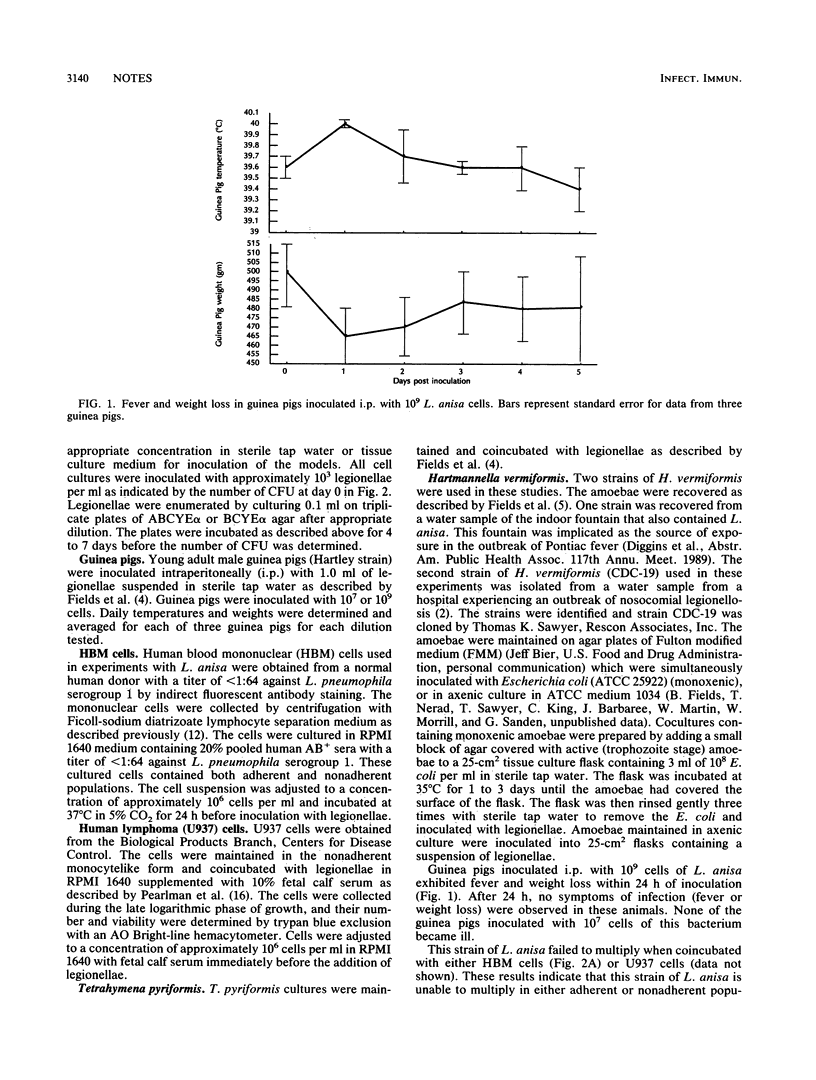Abstract
Legionella anisa and the amoeba Hartmannella vermiformis were isolated from an indoor fountain implicated as the infectious reservoir in an outbreak of Pontiac fever. We evaluated the ability of this strain of L. anisa to multiply in cultures of an amoeba (H. vermiformis), a ciliated protozoan (Tetrahymena pyriformis), and human mononuclear cells and to infect guinea pigs. These bacteria multiplied in the culture of H. vermiformis but failed to infect guinea pigs or the cultures of T. pyriformis and human mononuclear cells. These findings suggest that some Legionella spp. may multiply only in specific protozoan hosts. The inability of this strain of L. anisa to multiply in human phagocytic cells may be related to the development of Pontiac fever rather than pneumonic legionellosis in exposed individuals. Further studies are necessary to determine whether the ability of legionellae to infect certain host cells can be correlated to differences in human disease.
Full text
PDF



Selected References
These references are in PubMed. This may not be the complete list of references from this article.
- Bornstein N., Mercatello A., Marmet D., Surgot M., Deveaux Y., Fleurette J. Pleural infection caused by Legionella anisa. J Clin Microbiol. 1989 Sep;27(9):2100–2101. doi: 10.1128/jcm.27.9.2100-2101.1989. [DOI] [PMC free article] [PubMed] [Google Scholar]
- Breiman R. F., Fields B. S., Sanden G. N., Volmer L., Meier A., Spika J. S. Association of shower use with Legionnaires' disease. Possible role of amoebae. JAMA. 1990 Jun 6;263(21):2924–2926. [PubMed] [Google Scholar]
- Eickhoff T. C. Epidemiology of Legionnaires' disease. Ann Intern Med. 1979 Apr;90(4):499–502. doi: 10.7326/0003-4819-90-4-499. [DOI] [PubMed] [Google Scholar]
- Fields B. S., Barbaree J. M., Shotts E. B., Jr, Feeley J. C., Morrill W. E., Sanden G. N., Dykstra M. J. Comparison of guinea pig and protozoan models for determining virulence of Legionella species. Infect Immun. 1986 Sep;53(3):553–559. doi: 10.1128/iai.53.3.553-559.1986. [DOI] [PMC free article] [PubMed] [Google Scholar]
- Fields B. S., Shotts E. B., Jr, Feeley J. C., Gorman G. W., Martin W. T. Proliferation of Legionella pneumophila as an intracellular parasite of the ciliated protozoan Tetrahymena pyriformis. Appl Environ Microbiol. 1984 Mar;47(3):467–471. doi: 10.1128/aem.47.3.467-471.1984. [DOI] [PMC free article] [PubMed] [Google Scholar]
- Fraser D. W., Deubner D. C., Hill D. L., Gilliam D. K. Nonpneumonic, short-incubation-period Legionellosis (Pontiac fever) in men who cleaned a steam turbine condenser. Science. 1979 Aug 17;205(4407):690–691. doi: 10.1126/science.462175. [DOI] [PubMed] [Google Scholar]
- Friedman S., Spitalny K., Barbaree J., Faur Y., McKinney R. Pontiac fever outbreak associated with a cooling tower. Am J Public Health. 1987 May;77(5):568–572. [PMC free article] [PubMed] [Google Scholar]
- Girod J. C., Reichman R. C., Winn W. C., Jr, Klaucke D. N., Vogt R. L., Dolin R. Pneumonic and nonpneumonic forms of legionellosis. The result of a common-source exposure to Legionella pneumophila. Arch Intern Med. 1982 Mar;142(3):545–547. [PubMed] [Google Scholar]
- Herwaldt L. A., Gorman G. W., McGrath T., Toma S., Brake B., Hightower A. W., Jones J., Reingold A. L., Boxer P. A., Tang P. W. A new Legionella species, Legionella feeleii species nova, causes Pontiac fever in an automobile plant. Ann Intern Med. 1984 Mar;100(3):333–338. doi: 10.7326/0003-4819-100-3-333. [DOI] [PubMed] [Google Scholar]
- Horwitz M. A., Silverstein S. C. Activated human monocytes inhibit the intracellular multiplication of Legionnaires' disease bacteria. J Exp Med. 1981 Nov 1;154(5):1618–1635. doi: 10.1084/jem.154.5.1618. [DOI] [PMC free article] [PubMed] [Google Scholar]
- Kaufmann A. F., McDade J. E., Patton C. M., Bennett J. V., Skaliy P., Feeley J. C., Anderson D. C., Potter M. E., Newhouse V. F., Gregg M. B. Pontiac fever: isolation of the etiologic agent (Legionella pneumophilia) and demonstration of its mode of transmission. Am J Epidemiol. 1981 Sep;114(3):337–347. doi: 10.1093/oxfordjournals.aje.a113200. [DOI] [PubMed] [Google Scholar]
- Morrill W. E., Barbaree J. M., Fields B. S., Sanden G. N., Martin W. T. Increased recovery of Legionella micdadei and Legionella bozemanii on buffered charcoal yeast extract agar supplemented with albumin. J Clin Microbiol. 1990 Mar;28(3):616–618. doi: 10.1128/jcm.28.3.616-618.1990. [DOI] [PMC free article] [PubMed] [Google Scholar]
- Palutke W. A., Crane L. R., Wentworth B. B., Geiger J. G., Cardozo L., Singhakowinta A., Bartley J., Robinson B. E. Legionella feeleii-associated pneumonia in humans. Am J Clin Pathol. 1986 Sep;86(3):348–351. doi: 10.1093/ajcp/86.3.348. [DOI] [PubMed] [Google Scholar]
- Pearlman E., Jiwa A. H., Engleberg N. C., Eisenstein B. I. Growth of Legionella pneumophila in a human macrophage-like (U937) cell line. Microb Pathog. 1988 Aug;5(2):87–95. doi: 10.1016/0882-4010(88)90011-3. [DOI] [PubMed] [Google Scholar]
- Rowbotham T. J. Current views on the relationships between amoebae, legionellae and man. Isr J Med Sci. 1986 Sep;22(9):678–689. [PubMed] [Google Scholar]
- Rowbotham T. J. Pontiac fever explained? Lancet. 1980 Nov 1;2(8201):969–969. doi: 10.1016/s0140-6736(80)92120-0. [DOI] [PubMed] [Google Scholar]
- Rowbotham T. J. Preliminary report on the pathogenicity of Legionella pneumophila for freshwater and soil amoebae. J Clin Pathol. 1980 Dec;33(12):1179–1183. doi: 10.1136/jcp.33.12.1179. [DOI] [PMC free article] [PubMed] [Google Scholar]


